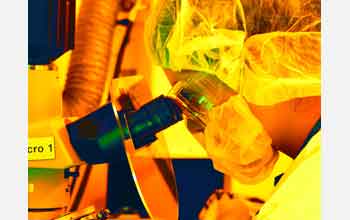Multimedia Gallery
ATE Centers (Image 12)
Technologists verify the quality of microelectromechanical systems products with microscopic inspections. The Southwest Center for Microsystems Education increases educational institutions' capacity to produce technologists with the skills to be successful in supporting microsystems research, design, fabrication and commercialization activities. [Image 12 of 12 related images. Back to Image 1.] (Date of Image: 2009)
More about this Image
Supported in part by the National Science Foundation's (NSF) Advanced Technological Education (ATE) program, the Southwest Center for Microsystems Education (SCME) provides professional development and educational materials to secondary and postsecondary educators; increases awareness of microelectromechanical systems (MEMS) technology through regional outreach to students, parents, educators and industry; and increases educational institutions' capacity to produce technologists with the skills to be successful in supporting microsystems research, design, fabrication and commercialization activities.
The center serves two-year institutions in the southwest by helping them adopt the curricula and materials SCME offers to prepare individuals for careers in microtechnology, nanotechnology and derivative fields. In addition to guiding students' learning in classrooms and labs, SCME personnel have coached CNM students to first place and honorable mention awards in the University Alliance MEMS competition sponsored by Sandia National Laboratories, SCME's partner. The community college students' successes demonstrate their acquisition of technical and teamwork skills.
SCME collaborates with Sandia National Laboratories on a job shadowing and profiling project, analyzing the attributes required for microsystems technologist occupations. The center also worked with corporate partners and Sandia National Laboratories to facilitate the establishment of internships and jobs for MEMS students at start-up and large-scale enterprises. SCME is located at the University of New Mexico in Albuquerque. To learn more, visit the center's website Here.
NSF's ATE program supports efforts to improve the knowledge and skills of technicians who work in high-technology fields that drive the nation's economy. The program focuses on undergraduates, secondary school students and incumbent technicians, as well as on the educators who teach them. Community colleges are the main providers of education for technicians and have leadership roles in all ATE initiatives, working closely with industry, government and educators in other sectors to enhance the skills of the men and women who are essential to the vitality of the nation's economy. ATE partnerships help create new curricula; reform existing programs; enrich the technical knowledge of experienced college faculty members and teachers; prepare prospective educators with solid foundations in science, technology, engineering and mathematics; and undertake applied research in technological education. Further information on NSF's ATE program is available Here.
Credit: Photo from ATE Centers Impact 2008-2010 (www.atecenters.org)
See other images like this on your iPhone or iPad download NSF Science Zone on the Apple App Store.
Images and other media in the National Science Foundation Multimedia Gallery are available for use in print and electronic material by NSF employees, members of the media, university staff, teachers and the general public. All media in the gallery are intended for personal, educational and nonprofit/non-commercial use only.
Images credited to the National Science Foundation, a federal agency, are in the public domain. The images were created by employees of the United States Government as part of their official duties or prepared by contractors as "works for hire" for NSF. You may freely use NSF-credited images and, at your discretion, credit NSF with a "Courtesy: National Science Foundation" notation.
Additional information about general usage can be found in Conditions.
Also Available:
Download the high-resolution JPG version of the image. (2.8 MB)
Use your mouse to right-click (Mac users may need to Ctrl-click) the link above and choose the option that will save the file or target to your computer.

